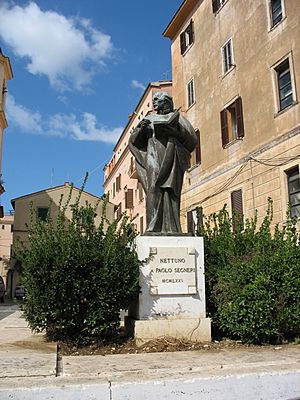Paolo Segneri facts for kids
Quick facts for kids |
|
|---|---|
 |
|
| Orders | |
| Ordination | 1653 |
| Personal details | |
| Born | March 21, 1624 Nettuno, Papal States |
| Died | 9 December 1694 (aged 70) Rome, Papal States |
| Nationality | Italian |
| Alma mater | Roman College |
Paolo Segneri (born March 21, 1624 – died December 9, 1694) was an important Italian Jesuit priest. He was famous for his powerful speeches and for being a missionary. He also wrote many books about spiritual life.
Contents
The Life of Paolo Segneri
Paolo Segneri was born in a town called Nettuno, Italy. He studied at the Roman College. In 1637, he joined the Society of Jesus, also known as the Jesuits. This was a religious group.
Early Studies and Priesthood
Paolo's father did not want him to join the Jesuits. But Paolo followed his heart. He learned from great teachers like Oliva and Sforza Pallavicino. These teachers helped him grow in his faith and talents.
He taught subjects like humanities for several years. In 1653, he became a priest. He prepared for his work by studying the Bible, writings of early Church leaders, and speeches by Cicero.
A Famous Preacher and Missionary
Paolo Segneri wanted to be a missionary in faraway lands. But instead, he worked in Italy. He traveled through Tuscany, the Papal States, and other big Italian cities.
He started by preaching in large cathedrals. Then, for 27 years (from 1665 to 1692), he gave popular missions. These were special events where he would preach to many people. His speeches were very powerful and inspiring.
Working with the Pope
One of his famous books was called "Quaresimale." It was read and admired by Antonio Pignatelli. This person later became Pope Innocent XII.
The Pope asked Segneri to preach to him and his court. The Pope was very impressed. He made Segneri a special theologian for the Paenitentiaria, which is an important office in the Catholic Church.
Paolo Segneri died in Rome. Many people believed he was one of Italy's greatest speakers, after St. Bernadine of Siena and Savonarola. He helped to improve how sermons were given in Italy.
His Impact
People from entire regions would come to hear him speak. Many special blessings and favors were linked to his work. Despite his great success, he remained humble and simple.
Paolo Segneri's Writings
Paolo Segneri wrote many important books. These books helped people learn about their faith and how to live a good life.
- Il penitente istruito (1669): This book helped people understand how to confess their sins.
- Il confessore istruito (1672): This book was for priests, teaching them how to hear confessions.
- La Manna dell anima (1683): This book offered spiritual guidance and comfort. It was like "manna" (food from heaven) for the soul.
- Il Cristiano istruito (1690): This book taught Christians how to live their faith.
One of his best books was "La concordia tra la fatica e la quiete." This book talks about meditation. It explains different ways to meditate and what the goals of meditation are.
His complete works have been published many times. His "Quaresimale" book alone has been printed at least 30 times. Some of his writings have even been translated into Arabic.
See also
 In Spanish: Paolo Segneri para niños
In Spanish: Paolo Segneri para niños


